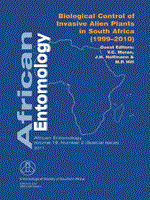Research initiated in 1988 on the biological control of the invasive Neotropical shrub Chromolaena odorata (L.) R.M.King & H.Rob. (Asteraceae) in South Africa is described in this review. The origin of the southern African C. odorata biotype has been determined as the Greater Antilles in the Caribbean. Regions of the Neotropics which are climatically similar to the area invaded by the weed in southern Africa have been identified, allowing for better climatic matching of potential biological control agents. Two insect agents, Pareuchaetes insulata (Walker) (Lepidoptera: Arctiidae), which was released in 2001, and Calycomyza eupatorivora Spencer (Diptera: Agromyzidae), released in 2003, have become established on C. odorata in South Africa, primarily in the wetter, coastal regions. While these agents have inflicted sporadic, localized damage on the weed, it is clear that their impact on C. odorata populations will be insufficient to effect adequate suppression of the weed throughout its invasive range in South Africa. Thus, research on a wide range of insect and pathogen species which have potential as biological control agents has been ongoing. Initial releases of a stem-boring weevil, Lixus aemulus Petri (Coleoptera: Curculionidae), have been made, and host-range testing of the shoot-tip borer Dichrorampha odorata Brown & Zachariades (Lepidoptera: Tortricidae) indicates that it is suitable for release. The root feeder Longitarsus sp. (Coleoptera: Chrysomelidae) was rejected because it was shown to have a wide host range. Four promising insect species are currently being investigated, namely the stem galler Conotrachelus reticulatus Champion (Coleoptera: Curculionidae), the stem borer Carmenta chromolaenae Eichlin (Lepidoptera: Sesiidae), the stem and root-crown borer Recchia parvula (Lane) (Coleoptera: Cerambycidae) and the shoot-tip borer Melanagromyza eupatoriella Spencer (Diptera: Agromyzidae). Sustained efforts have been made to collect and isolate pathogens from C. odorata in the Americas, but all pathogens either failed to produce symptoms or were insufficiently virulent on the southern African biotype of the target plant. Although considerable efforts and resources have been expended on research and implementation of biological control against C. odorata, the plant is not yet under any significant degree of biological control in South Africa and it continues to be a weed of national and international importance.
BioOne.org will be down briefly for maintenance on 17 December 2024 between 18:00-22:00 Pacific Time US. We apologize for any inconvenience.
How to translate text using browser tools
1 August 2011
Progress towards the biological control of Chromolaena odorata (L.) R.M.King & H.Rob. (Asteraceae) in South Africa
C. Zachariades,
L.W. Strathie,
E. Retief,
N. Dube
ACCESS THE FULL ARTICLE
It is not available for individual sale.
This article is only available to subscribers.
It is not available for individual sale.
It is not available for individual sale.

African Entomology
Vol. 19 • No. 2
August 2011
Vol. 19 • No. 2
August 2011
Calycomyza
chromolaena
climatic matching
Lixus
native range
Pareuchaetes




